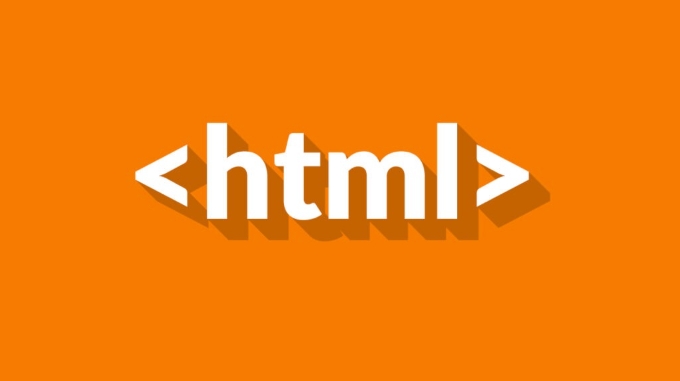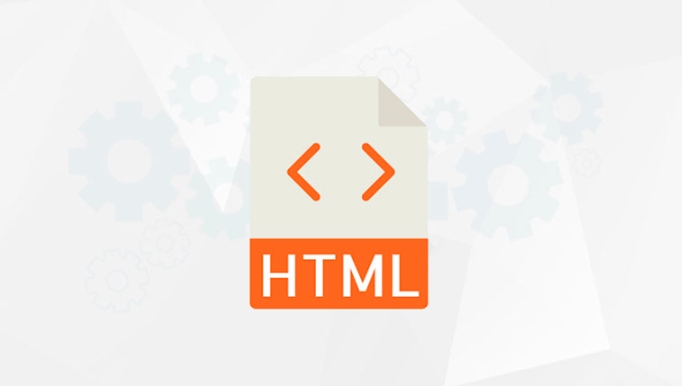Creating responsive HTML messages requires the following methods: 1. Ensure compatibility with inline styles; 2. Replace Flexbox or Grid with table layout; 3. Set viewport tags, fixed-width containers, picture max-width, and mobile adaptation with table simulation buttons; 4. Previews must be tested on multiple clients and real devices. This can improve the display stability and user experience on different devices and email clients.

Creating a responsive HTML message is indeed a bit challenging because the support for HTML and CSS is chaotic across major mail clients. But if your goal is to make emails appear normally on different devices, there are some practical ways to follow.

Using Inline Styles
Most mail clients have limited support for <style></style> tags, or even completely ignored. To ensure that your style can be applied correctly, it is best to write CSS directly in the style attribute of the tag.
for example:

<table border="0" cellpadding="0" cellpacing="0" width="100%">
<tr>
<td style="font-family: Arial, sans-serif; font-size: 16px; color: #333;">
This is a text with a stable style.
</td>
</tr>
</table>Although it is a bit troublesome to write, it is a key step to ensure compatibility.
Table-based Layout
Responsive web pages often use Flexbox or Grid layouts, but these are basically unavailable in HTML mail. Instead, the ancient <table> layout is replaced.

- Clear table structure and strong compatibility
- A certain degree of adaptability can be achieved by setting the width to a percentage
To give a simple example:
<table width="100%" border="0" cellpacing="0" cellpadding="0">
<tr>
<td width="50%" style="padding: 10px;">Left content</td>
<td width="50%" style="padding: 10px;">Right content</td>
</tr>
</table>This way, it can maintain a good layout effect even in the old version of Outlook.
Mobile adaptation skills
Although you cannot use media queries to be truly "responsive", you can do some basic optimizations to make the mobile experience better:
Set the viewport meta tag (although some email clients may ignore):
<meta name="viewport" content="width=device-width, initial-scale=1.0">
Use a fixed width container, for example, the maximum width is set to 600px, centered to display
Image setting
max-width: 100%to ensure that the screen does not exceedButtons are simulated using
<table> , notCSSYou can also define some styles for mobile devices. Although not all clients support them, they can at least improve the reading experience of some users.
Testing and previewing are essential
The most troublesome thing about HTML emails is that "it looks OK" does not mean "everyone can see the correct effect." So be sure to test it!
- Preview in multiple mail clients (such as Gmail, Outlook, Apple Mail, Yahoo Mail, etc.)
- Use tools such as Litmus or Email on Acid
- Send it to yourself or colleagues to see the results on real devices
The test step cannot be skipped, otherwise it is easy to have an embarrassing situation of "only after sending it out, you will find that the layout is inconsistent".
Basically that's it. HTML email development is not as free as web pages, but as long as you master the routine, you can also create stable and beautiful email templates.
The above is the detailed content of How to create a responsive HTML email?. For more information, please follow other related articles on the PHP Chinese website!

Hot AI Tools

Undress AI Tool
Undress images for free

Undresser.AI Undress
AI-powered app for creating realistic nude photos

AI Clothes Remover
Online AI tool for removing clothes from photos.

Clothoff.io
AI clothes remover

Video Face Swap
Swap faces in any video effortlessly with our completely free AI face swap tool!

Hot Article

Hot Tools

Notepad++7.3.1
Easy-to-use and free code editor

SublimeText3 Chinese version
Chinese version, very easy to use

Zend Studio 13.0.1
Powerful PHP integrated development environment

Dreamweaver CS6
Visual web development tools

SublimeText3 Mac version
God-level code editing software (SublimeText3)
 Applying Semantic Structure with article, section, and aside in HTML
Jul 05, 2025 am 02:03 AM
Applying Semantic Structure with article, section, and aside in HTML
Jul 05, 2025 am 02:03 AM
The rational use of semantic tags in HTML can improve page structure clarity, accessibility and SEO effects. 1. Used for independent content blocks, such as blog posts or comments, it must be self-contained; 2. Used for classification related content, usually including titles, and is suitable for different modules of the page; 3. Used for auxiliary information related to the main content but not core, such as sidebar recommendations or author profiles. In actual development, labels should be combined and other, avoid excessive nesting, keep the structure simple, and verify the rationality of the structure through developer tools.
 Implementing Clickable Buttons Using the HTML button Element
Jul 07, 2025 am 02:31 AM
Implementing Clickable Buttons Using the HTML button Element
Jul 07, 2025 am 02:31 AM
To use HTML button elements to achieve clickable buttons, you must first master its basic usage and common precautions. 1. Create buttons with tags and define behaviors through type attributes (such as button, submit, reset), which is submitted by default; 2. Add interactive functions through JavaScript, which can be written inline or bind event listeners through ID to improve maintenance; 3. Use CSS to customize styles, including background color, border, rounded corners and hover/active status effects to enhance user experience; 4. Pay attention to common problems: make sure that the disabled attribute is not enabled, JS events are correctly bound, layout occlusion, and use the help of developer tools to troubleshoot exceptions. Master this
 Configuring Document Metadata Within the HTML head Element
Jul 09, 2025 am 02:30 AM
Configuring Document Metadata Within the HTML head Element
Jul 09, 2025 am 02:30 AM
Metadata in HTMLhead is crucial for SEO, social sharing, and browser behavior. 1. Set the page title and description, use and keep it concise and unique; 2. Add OpenGraph and Twitter card information to optimize social sharing effects, pay attention to the image size and use debugging tools to test; 3. Define the character set and viewport settings to ensure multi-language support is adapted to the mobile terminal; 4. Optional tags such as author copyright, robots control and canonical prevent duplicate content should also be configured reasonably.
 Best HTML tutorial for beginners in 2025
Jul 08, 2025 am 12:25 AM
Best HTML tutorial for beginners in 2025
Jul 08, 2025 am 12:25 AM
TolearnHTMLin2025,chooseatutorialthatbalanceshands-onpracticewithmodernstandardsandintegratesCSSandJavaScriptbasics.1.Prioritizehands-onlearningwithstep-by-stepprojectslikebuildingapersonalprofileorbloglayout.2.EnsureitcoversmodernHTMLelementssuchas,
 HTML for email templates tutorial
Jul 10, 2025 pm 02:01 PM
HTML for email templates tutorial
Jul 10, 2025 pm 02:01 PM
How to make HTML mail templates with good compatibility? First, you need to build a structure with tables to avoid using div flex or grid layout; secondly, all styles must be inlined and cannot rely on external CSS; then the picture should be added with alt description and use a public URL, and the buttons should be simulated with a table or td with background color; finally, you must test and adjust the details on multiple clients.
 How to associate captions with images or media using the html figure and figcaption elements?
Jul 07, 2025 am 02:30 AM
How to associate captions with images or media using the html figure and figcaption elements?
Jul 07, 2025 am 02:30 AM
Using HTML sums allows for intuitive and semantic clarity to add caption text to images or media. 1. Used to wrap independent media content, such as pictures, videos or code blocks; 2. It is placed as its explanatory text, and can be located above or below the media; 3. They not only improve the clarity of the page structure, but also enhance accessibility and SEO effect; 4. When using it, you should pay attention to avoid abuse, and apply to content that needs to be emphasized and accompanied by description, rather than ordinary decorative pictures; 5. The alt attribute that cannot be ignored, which is different from figcaption; 6. The figcaption is flexible and can be placed at the top or bottom of the figure as needed. Using these two tags correctly helps to build semantic and easy to understand web content.
 What are the most commonly used global attributes in html?
Jul 10, 2025 am 10:58 AM
What are the most commonly used global attributes in html?
Jul 10, 2025 am 10:58 AM
class, id, style, data-, and title are the most commonly used global attributes in HTML. class is used to specify one or more class names to facilitate style setting and JavaScript operations; id provides unique identifiers for elements, suitable for anchor jumps and JavaScript control; style allows for inline styles to be added, suitable for temporary debugging but not recommended for large-scale use; data-properties are used to store custom data, which is convenient for front-end and back-end interaction; title is used to add mouseover prompts, but its style and behavior are limited by the browser. Reasonable selection of these attributes can improve development efficiency and user experience.
 How to handle forms submission in HTML without a server?
Jul 09, 2025 am 01:14 AM
How to handle forms submission in HTML without a server?
Jul 09, 2025 am 01:14 AM
When there is no backend server, HTML form submission can still be processed through front-end technology or third-party services. Specific methods include: 1. Use JavaScript to intercept form submissions to achieve input verification and user feedback, but the data will not be persisted; 2. Use third-party serverless form services such as Formspree to collect data and provide email notification and redirection functions; 3. Use localStorage to store temporary client data, which is suitable for saving user preferences or managing single-page application status, but is not suitable for long-term storage of sensitive information.






